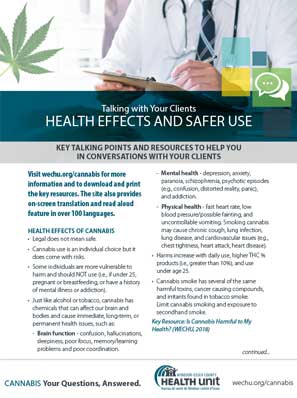
KEY TALKING POINTS AND RESOURCES TO HELP YOU
IN CONVERSATIONS WITH YOUR CLIENTS
HEALTH EFFECTS OF CANNABIS
- Legal does not mean safe.
- Cannabis use is an individual choice but it does come with risks.
- Some individuals are more vulnerable to harm and should NOT use (i.e., if under 25, pregnant or breastfeeding, or have a history of mental illness or addiction).
- Just like alcohol or tobacco, cannabis has chemicals that can affect our brain and bodies and cause immediate, long-term, or permanent health issues, such as:
- Brain function - confusion, hallucinations, sleepiness, poor focus, memory/learning problems and poor coordination.
- Mental health - depression, anxiety, paranoia, schizophrenia, psychotic episodes (e.g., confusion, distorted reality, panic), and addiction.
- Physical health - fast heart rate, low blood pressure/possible fainting, and uncontrollable vomiting. Smoking cannabis may cause chronic cough, lung infection, lung disease, and cardiovascular issues (e.g., chest tightness, heart attack, heart disease).
- Harms increase with daily use, higher THC % products (i.e., greater than 10%), and use under age 25.
- Cannabis smoke has several of the same harmful toxins, cancer causing compounds, and irritants found in tobacco smoke. Limit cannabis smoking and exposure to secondhand smoke.
SAFER USE METHODS
- The safest option is to NOT use cannabis
- Delay using cannabis until after age 25
- Choose low THC% products (under 10%)
- Don’t use often. (use once per week or less)
- Don’t use synthetic products like K2/spice
- Avoid smoking cannabis or harmful smoking practices (e.g., breath-holding, deep inhalation)
- Don’t mix with alcohol or tobacco
- Don’t use cannabis before driving
- Don’t use if pregnant or breastfeeding
ACTIVE INGREDIENTS (THC/CBD) AND ALTERNATIVE METHODS TO SMOKING
- Cannabis products differ in their type, level of active ingredients, and effects on the brain and body. The main active ingredients are THC and CBD.
- “Start low, go slow” with ANY product (i.e., low concentration of THC, small amount of product).
- Keep edibles and other cannabis products securely stored and away from children and pets.
THC (tetrahydrocannabinol): Psychoactive,mind-altering, intoxicating chemical. Makes users feel “high” .
- Affects mental state, emotions, and behaviour
- Higher THC% products can cause long-term damage to brain function and mental health.
CBD (cannabidiol): Does not give users a “high”/intoxicating effect.
- High CBD potency products can reduce the effects of THC.
Edibles, oils, and capsules: Peak effects can be delayed from 2-4 hours. Start with a small amount and wait at least 2 hours before consuming any more to avoid overconsuming and a possible bad reaction.
ANSWERING QUESTIONS ABOUT MEDICAL CANNABIS
- Medical strains are typically different from non-medical (recreational) strains and have more CBD and less THC.
- Any therapeutic use should be discussed with and monitored by a healthcare provider.
GETTING HELP WITH SUBSTANCE USE
Urgent help
- Windsor-Essex Crisis Line: 519-973-4435 (24 hour/7 days a week)
- Kids Help Phone: 1-800-668-6868 www.kidshelpphone.ca (phone or online chat counselling, English and French)
- If unintentional ingestion or bad reaction, call 911 or the Ontario Poison Centre: 1-800-268-9017
Find local treatment services
- Visit www.wechu.org/GetHelp: Directory of helplines and local treatment services for mental health and addictions. Can download and print a Treatment Options Brochure from this page
- Call Connex Ontario: 1-866-531-2600 www.connexontario.ca (24/7 support in 100+ languages)
References
Barrus, D., Capogrossi, K., Cates, S., Gourdet, C., Peiper, N., Novak, S.,… Wiley, J. (2016). Tasty THC: Promises and challenges of cannabis edibles. Research Triangle Park, NC: RTI Press.
Canadian Centre on Substance Abuse. (2016). Clearing the smoke on cannabis: Highlights. Retrieved from https://www.ccsa.ca/clearing-smoke-cannabis-highlights
Centre for Addiction and Mental Health. (2018). Canada’s lower-risk cannabis use guidelines. Retrieved from https://www.camh.ca/-/media/files/pdfs---reports-and-books---research/canadas-lower-risk-guidelines-cannabis-pdf.pdf
Health Canada. (2016). Access to cannabis for medical purposes regulations: Daily amount fact sheet (dosage). Retrieved from https://www.canada.ca/en/health-canada/services/drugs-medication/cannabis/information-medical-practitioners/cannabis-medical-purposes-regulations-daily-amount-fact-sheet-dosage.html



